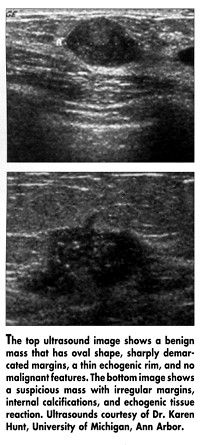Ultrasound Could Prevent Unnecessary Breast Biopsies
ATLANTA-When used to distinguish benign and malignant solid masses, high-resolution ultrasound may reduce the number of breast biopsies by as much as 28%, said Karen Hunt, MD, assistant professor of radiology, University of Michigan, Ann Arbor. Dr. Hunt, who is also senior staff radiologist at Henry Ford Hospital, presented the findings at the 102nd Annual Meeting of the American Roentgen Ray Society’s (abstract 138).
ATLANTAWhen used to distinguish benign and malignant solid masses, high-resolution ultrasound may reduce the number of breast biopsies by as much as 28%, said Karen Hunt, MD, assistant professor of radiology, University of Michigan, Ann Arbor. Dr. Hunt, who is also senior staff radiologist at Henry Ford Hospital, presented the findings at the 102nd Annual Meeting of the American Roentgen Ray Society’s (abstract 138).
The researchers evaluated 157 solid masses in 141 women. Of these lesions, they identified 57 abnormal masses by mammography, 2 by MRI, and 98 by palpation. Mean tumor size was 17 mm (range, 5 mm to 80 mm).

Eleven dedicated breast-imaging radiologists performed ultrasound examinations and classified the masses prospectively as benign or suspicious using a "gestalt" evaluation technique. According to Dr. Hunt, the gestalt technique is difficult to define, but is based on the radiologists’ experience. The masses were also classified based on the previously published Stavros criteria that define how a benign or malignant mass might appear on ultrasound (see Figure).
Biopsies were then performed on 137 of the 157 masses, and from the biopsies, 55 (40%) were classified as malignant and 82 (60%) as benign.
With the gestalt evaluation technique, 38 (46%) of the 82 histologically benign masses were classified as benign, and all 55 (100%) of the cancers were classified as suspicious. Therefore, this method would have prevented 38 biopsies, reducing the rate by 28%, Dr. Hunt said.
The Stavros criteria was slightly less effective in identifying benign masses, classifying 24 (29%) of the 82 benign masses correctly, but, as with the gestalt method, all 55 of the cancers were classified as suspicious. Therefore, this method would have prevented 24 biopsies, reducing the rate by 18%. The advantage of the Stavros criteria, she said, is that specific sonographic descriptors can be more easily replicated from institution to institution.
"With larger numbers of masses evaluated, we expect that a few cancers may appear benign on ultrasound," Dr. Hunt noted. "We expect this to be quite rare, so imaging surveillance can be safely offered as an alternative to biopsy. Ultrasound is a reliable test that should be part of the approach to diagnosing these patients."
Dr. Hunt also pointed out that the findings cannot be generalized to practitioners using lower resolution imaging or those looking at a hard copy of the scan.
"But I believe that in dedicated breast imaging facilities, radiologists will be able to get results similar to ours," she said.
Newsletter
Stay up to date on recent advances in the multidisciplinary approach to cancer.